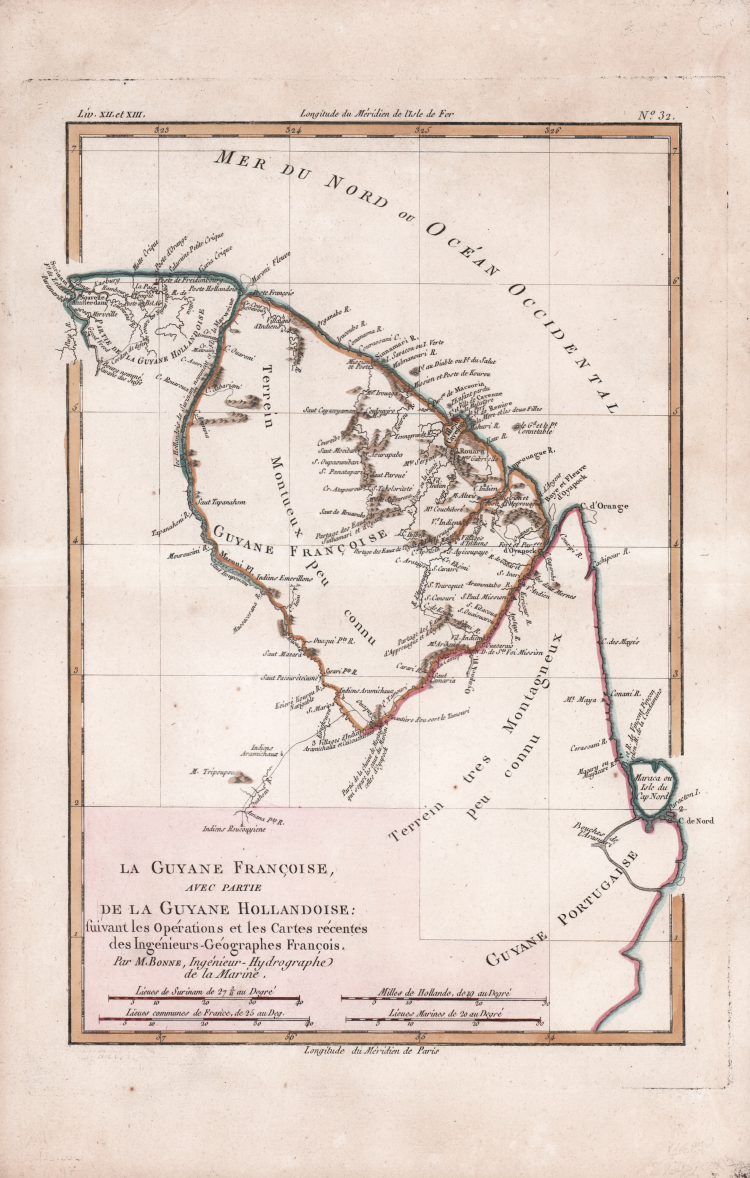



| Reference: | S20784 |
| Author | Rigobert BONNE |
| Year: | 1787 ca. |
| Zone: | Guiana |
| Printed: | Paris |
| Measures: | 245 x 350 mm |


| Reference: | S20784 |
| Author | Rigobert BONNE |
| Year: | 1787 ca. |
| Zone: | Guiana |
| Printed: | Paris |
| Measures: | 245 x 350 mm |
South America antique map shows British & Dutch Guyana (Suriname) in the 18th century.
Map taken from the “Atlas encyclopédique, contenant la géographie ancienne et quelques cartes sur la géographie du Moyen Âge, la géographie moderne, et les cartes relatives à la géographie physique” by R. Bonnè and Nicolas Desmarest, printed in Paris "Par M. Bonne, Ingénieur-Hydrographe de la Marine, et par M. Desmarest, de L'Académie Royale des Sciences", 1787-88.
Bonne was one of the most influential French cartographers of the eighteenth century, so much so that he was chosen as the successor of Jacques Nicolas Bellin to the Depot de la Marine as a hydrograph of His Royal Highness Louis XVI.
The Atlas Encyclopédique, that Bonne completed with the help of Nicholas Desmarest, constitutes his most famous work.
Copperplate, fine later hand colour, in good conditions.
Rigobert BONNE (1727 - 1795 ca.)
|
Rigobert Bonne was born in 1727 in Raucourt, in the Lorraine region of northeastern France. He was not only a cartographer but also a hydrographer who produced both land and nautical maps; he spent much of his career working in the French Hydrographic Office or Dépôt des cartes et plans de la Marine. As Royal Hydrographer, Bonne's main interest was the production of nautical maps, but he also gave to print a considerable number of other works, including maps by other cartographers who were his collaborators. He first came to prominence producing a series of plates for the Atlas Moderne ou Collection De Cartes Sur toutes les parties du Globe Terrestre par Plusieurs Auteurs, edited by Giovanni Antonio Rizzi Zannoni and first published in Paris by Jean Lattré in 1762, and subsequently reprinted-with the addition of numerous plates by other cartographers-until the end of the century. But he is probably best known for later publications, including the Atlas Encyclopedique-in collaboration with Nicholas Desmarest (1725-1805)-as well as for the maps he made for Guillaume Raynal's Atlas de Toutes Les Parties Connues du Globe Terrestre (1780). His maps were often commissioned more for educational and informational purposes than for practical use. In 1773, Bonne's talent was rewarded with the title of "Hydrographe du Roy," succeeding Jacques-Nicolas Bellin. From him took its name the pseudoconic projection, adopted, among other things, for the general map of France.
|
Rigobert BONNE (1727 - 1795 ca.)
|
Rigobert Bonne was born in 1727 in Raucourt, in the Lorraine region of northeastern France. He was not only a cartographer but also a hydrographer who produced both land and nautical maps; he spent much of his career working in the French Hydrographic Office or Dépôt des cartes et plans de la Marine. As Royal Hydrographer, Bonne's main interest was the production of nautical maps, but he also gave to print a considerable number of other works, including maps by other cartographers who were his collaborators. He first came to prominence producing a series of plates for the Atlas Moderne ou Collection De Cartes Sur toutes les parties du Globe Terrestre par Plusieurs Auteurs, edited by Giovanni Antonio Rizzi Zannoni and first published in Paris by Jean Lattré in 1762, and subsequently reprinted-with the addition of numerous plates by other cartographers-until the end of the century. But he is probably best known for later publications, including the Atlas Encyclopedique-in collaboration with Nicholas Desmarest (1725-1805)-as well as for the maps he made for Guillaume Raynal's Atlas de Toutes Les Parties Connues du Globe Terrestre (1780). His maps were often commissioned more for educational and informational purposes than for practical use. In 1773, Bonne's talent was rewarded with the title of "Hydrographe du Roy," succeeding Jacques-Nicolas Bellin. From him took its name the pseudoconic projection, adopted, among other things, for the general map of France.
|